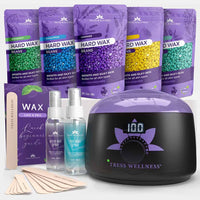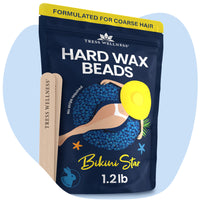Dealing with ingrown hair doesn’t have to be complex or painful. You need effective, at-home methods that promise relief without the fluff. This guide cuts to the chase on how to get rid of ingrown hair using safe, practical steps that you can immediately apply. Discover how warm compresses, proper exfoliation, and smart tweezing can transform your skin care routine and keep ingrown hairs at bay.
Key Takeaways
-
Ingrown hair occur when removed hairs grow back and reenter the skin, causing irritation, and are more common in individuals with tightly curled hair or curved hair follicles.
-
Preventing and removing ingrown hairs involves applying warm compresses, exfoliating to clear clogged pores, and safe tweezing, along with considering waxing over shaving for longer lasting smooth skin.
-
Proper aftercare is key to soothing skin post-hair removal, with products like hydrocortisone cream and aloe vera, and alternative hair removal methods like laser and electrolysis can offer more permanent solutions.
Understanding Ingrown Hair: The Basics

First things first, what is an ingrown hair? It’s when hair that has been removed grows back and reenters the skin, leading to irritation. They can present as tiny swollen bumps, or small pus-filled blisters, or cause burning and itching, sometimes referred to as ingrown hair bumps or barber bumps. Ingrown pubic hair, in particular, can be quite uncomfortable and requires proper care.
Certain factors make some individuals more susceptible to ingrown hairs. For instance, having tightly curled hair or a curved hair follicle can cause hair to curve back into the skin after being cut. Typically, ingrown hairs, including ingrown pubic hairs, appear in areas that are often subject to shaving, such as:
-
the face
-
neck
-
armpits
-
legs
Causes Behind Ingrown Hair Formation
You might be wondering, “What exactly causes these ingrown hair?” Well, there are a few causes:
-
A sharp-edged hair from shaving piercing the skin
-
When the skin is pulled while shaving, it makes the hair retract into the skin
-
The structure of your hair - for those with tightly curled hair or a curved follicle structure, the hair may grow back into the skin after being cut.
Did you know that dead skin cells can also be culprits? They can clog hair follicles, which prevents the hair from growing outward and leads to sideways growth under the skin. Additionally, individuals with high levels of certain sex hormones, which increases hair growth, can be more susceptible to developing ingrown hairs, especially after hair removal processes like shaving.
Step-by-Step Guide to Removing Ingrown Hair
Now that we’ve tackled the causes of ingrown hairs, let’s get down to the solution. Removing ingrown hairs can be done at home with some simple steps. The process involves applying a warm compress, exfoliating the area, and using sterilized tweezers to gently pull out the hair loop.
Read on as we delve into each step in detail.
Warm Compress Method
Warm compresses can be a game-changer when dealing with ingrown hairs. Here’s how to treat ingrown hair using them effectively:
-
Apply a warm compress to the affected skin for 10 to 15 minutes.
-
The warmth from the compress will open pores, facilitating the release of trapped hairs.
-
The warmth also softens the skin, making it easier for hairs to grow outwards.
To make a warm compress, simply soak a washcloth in warm water, wring out the excess, and apply it to the affected area. Repeat this process a few times until you see the hair close to the skin surface. With regular application, you’ll notice it becomes easier for hairs to grow outwards and prevent them from going back into your skin.
Exfoliation Techniques
Exfoliation is another essential step in removing ingrown hairs. It helps prevent ingrown hairs by removing dead skin cells that can block hair follicles. For body areas like the bikini line and underarms, use physical exfoliators like a dry brush or a granular scrub to lift ingrown hairs to the surface.
On the face, opt for chemical exfoliants or very gentle physical exfoliants to prevent complications. Gentle scrubs like Peter Thomas Roth Clinical Skin Care Botanical Buffing Beads Body Wash are recommended by dermatologists. Remember to use warm water and small, circular motions with a washcloth, brush, or scrub to free ingrown hairs and clear away dead skin cells.
Safe Tweezing Practices
After warming and exfoliating, you might see the hair loop close to the skin surface. This is when safe and sterile tweezing comes into play. To prevent infection, start by cleaning the surrounding skin with rubbing alcohol. This will help create a clean and sanitized area before you proceed with any procedures. Then, use a sterile needle or tweezer to gently lift and free the hair without digging into the skin.
Specialized ingrown hair tweezers with long pointed precision tips work best to remove hairs beneath the skin surface without causing damage. Remember, after removal, it’s crucial to disinfect the tweezers to prevent the spread of bacteria.
Choosing Wax Over Shave: A Preventative Measure

A shift in your hair removal method can also work wonders in treat and prevent ingrown hair. Did you know that waxing, as opposed to shaving, can reduce the risk of ingrown hair? Waxing removes hair from the root, resulting in a longer duration of smooth skin compared to shaving, which merely cuts the hair at the surface. Regular waxing can even make hair grow back finer and thinner over time, potentially preventing ingrown hairs. However, hard wax is a much better option when you are going for waxing because it is gentler on your skin compared to soft wax. It also gets the job done effectively by sticking just to the hair and not the skin. Since, soft wax sticks to the skin as well, it often fails to uproot the hair and just gets rid of the top layer of dead skin causing more ingrowns.
Tress Wellness’s hard wax beads offer a convenient and effective solution. They are:
-
Suitable for all body parts
-
Increase the applicability for preventing ingrown hairs across the body
-
Available in soothing scents like tea tree and lavender, adding a relaxing element to the waxing process.
For those stubborn and pesky ingrowns in your pubic area, try Tress Wellness Bikini Star Beads. These are designed especially for the coarse hair down South making them perfect for being tough on those ingrowns.
Aftercare: Soothing Your Skin Post-Removal
After successfully removing ingrown hairs, it’s crucial not to neglect aftercare. Post-removal aftercare includes applying products like hydrocortisone cream and aloe vera gel to soothe and protect the skin. Using a soothing serum post-shaving can help calm the skin and reduce the risk of ingrown hairs.
Hydrating the skin is equally important. Here are some products that can help moisturize and prevent dryness after shaving:
-
Hyaluronic acid or ceramide-based moisturizer
-
Glycolic acid body wash
-
Lactic acid cream
Regular use of these products can keep the skin exfoliated and prevent flaky, itchy patches post-shaving.
Alternative Hair Removal Methods to Consider
If waxing or shaving doesn’t seem to be working for you, don’t lose hope. There are alternative hair removal methods like laser hair removal and electrolysis that can help prevent ingrown hairs and ensure smooth skin. Laser hair removal targets the hair follicle, potentially offering a more durable solution, while electrolysis destroys the hair follicle with an electric current, effective across all hair and skin types.
Threading is another ancient technique using a twisted cotton thread, providing precision in hair removal, particularly for shaping eyebrows. However, it’s important to note that each of these methods has its own post-procedure care. For laser hair removal and electrolysis, this includes sun protection and gentle skin care, while threading may cause temporary irritation but generally has fewer side effects.
Tips to Prevent Future Ingrown Hair
Besides changing your hair removal method, there are other tips you can follow to prevent ingrown hair, it's not only about the method of hair removal but also about overall skin care. Here are some tips to minimize the risk of developing ingrown hairs:
-
Moisturize Regularly: Hydration is key for maintaining skin elasticity and preventing the dryness that can cause hairs to curl back into the skin. This is especially crucial for those with coarse or curly hair, which is more prone to ingrown hairs.
-
Let It Grow: Allowing hairs to grow without cutting them can reduce the risk of ingrown hairs. If hair removal is necessary, prep the skin with a gentle exfoliating wash to clear away dead skin cells that can trap hairs.
-
Active Ingredient: Using a benzoyl peroxide wash can help reduce bumps and ingrown hair.
-
Don't shave in between waxing sessions: In between waxes, avoid shaving to maintain the benefits of waxing and prevent disruption to the hair growth cycle.
When to Seek Professional Help
While most ingrown hairs can be handled at home, it’s important to know when to seek professional help. If there are signs of severe infection or complications like:
-
bacterial infections
-
keloids
-
persistent razor bumps
-
changes like hyperpigmentation or depressed scars
Don’t hesitate to consult a healthcare provider to treat and prevent potential health issues.
Similarly, if ingrown hairs are frequently causing problems or infections often recur, seek medical advice as it may point to an underlying health issue. Immediate consultation with a healthcare provider is necessary if there are symptoms of a staph infection, such as a pimple at the follicle with warmth or swelling, fever, or a general feeling of illness.
Summary
We’ve covered a lot of ground in our quest to understand and combat ingrown hairs. From understanding the causes to learning effective removal techniques, we’re sure you’re now armed with all the knowledge you need to tackle this common issue. Remember, consistent skin care, appropriate hair removal methods, and diligent aftercare are crucial in mitigating the occurrence of ingrown hairs.
We hope you find our guide helpful and feel more confident in dealing with ingrown hairs. Here’s to smoother, healthier skin!
Frequently Asked Questions
How do you draw out an ingrown hair?
To draw out an ingrown hair, apply a hot compress or soak in warm water to encourage it to come out. Use sterilized tweezers to remove the hair once it's close to the skin's surface.
How do you get rid of an ingrown hair cyst?
To get rid of an ingrown hair cyst, keep the area clean, avoid shaving around it, and apply warm compresses to help the hair grow out and drain, or use antibiotic ointment after cleaning. Avoid squeezing or popping the cyst to prevent infection.
Can you pop an ingrown hair?
No, you should not pop or pick at ingrown hairs as it can lead to infections and scarring. Instead, gently cleanse the area with warm water and soap to help the hair come out on its own.
Do ingrown hairs go away by itself?
Yes, ingrown hairs usually go away on their own within a couple of weeks, but it's best to avoid picking or tweezing them to prevent further irritation or potential infection.
How do you get rid of an ingrown hair fast?
To get rid of an ingrown hair fast, try using warm compresses to soften the skin and then carefully remove the ingrown hair with clean angled tweezers. Afterward, rinse the skin and apply a soothing after-shave product for relief.




